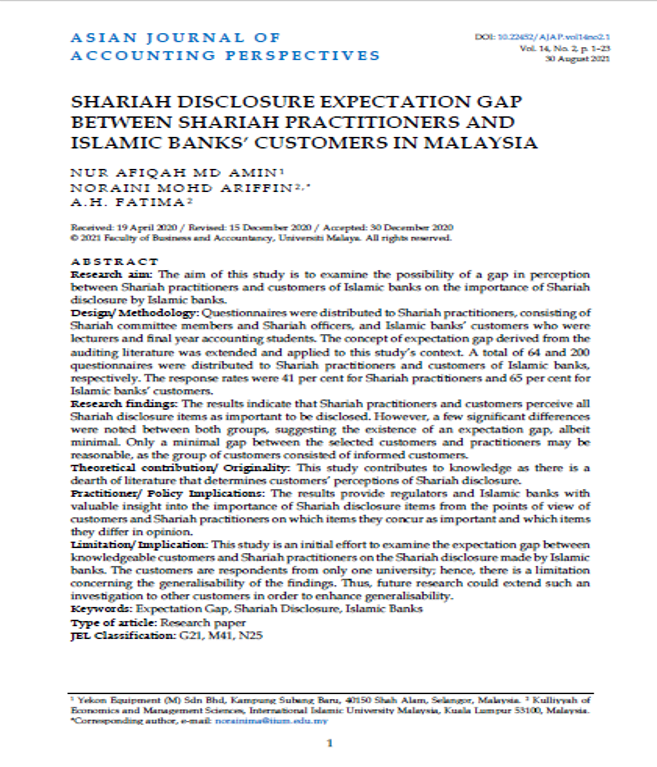Shariah disclosure expectation gap between Shariah practitioners and Islamic banks’ customers in Malaysia
Main Article Content
Abstract
Research aim: The aim of this study is to examine the possibility of a gap in perception between Shariah practitioners and customers of Islamic banks on the importance of Shariah disclosure by Islamic banks.
Design/ Methodology: Questionnaires were distributed to Shariah practitioners, consisting of Shariah committee members and Shariah officers, and Islamic banks’ customers who were lecturers and final year accounting students. The concept of expectation gap derived from the auditing literature was extended and applied to this study’s context. A total of 64 and 200 questionnaires were distributed to Shariah practitioners and customers of Islamic banks, respectively. The response rates were 41% for Shariah practitioners and 65% for Islamic banks’ customers.
Research findings: The results indicate that Shariah practitioners and customers perceive all Shariah disclosure items as important to be disclosed. However, a few significant differences were noted between both groups, suggesting the existence of an expectation gap, albeit minimal. Only a minimal gap between the selected customers and practitioners may be reasonable, as the group of customers consisted of informed customers.
Theoretical contribution/ Originality: This study contributes to knowledge as there is a dearth of literature that determines customers’ perceptions of Shariah disclosure.
Practitioner/ Policy Implications: The results provide regulators and Islamic banks with valuable insight into the importance of Shariah disclosure items from the points of view of customers and Shariah practitioners on which items they concur as important and which items they differ in opinion.
Limitation/ Implication: This study is an initial effort to examine the expectation gap between knowledgeable customers and Shariah practitioners on the Shariah disclosure made by Islamic banks. The customers are respondents from only one university; hence, there is a limitation concerning the generalisability of the findings. Thus, future research could extend such an investigation to other customers in order to enhance generalizability.
Keywords: Expectation Gap, Shariah Disclosure, Islamic Banks
Type of article: Research paper
JEL Classification: G21, M41, N25
Downloads
Article Details
License
The Asian Journal of Accounting Perspectives (AJAP) articles are published under a licence equivalent to the Creative Commons Attribution-NonCommercial-NoDerivs License (CC BY-NC-ND). The licence allows users to copy, distribute, and transmit an article as long as the author is attributed. The article is not used for commercial purposes. The work is not modified or adapted in any way.
Copyright
Authors are required to sign the Exclusive License to Publish agreement upon publication in the AJAP. The agreement grants the Publisher (Faculty of Business and Accountancy, Universiti Malaya) to publish and disseminate the articles.
Open Access
Articles published in the AJAP are digital, online, free of charge, and free of most copyright and licensing restrictions.
Article Processing Charge
Articles publish in AJAP is free submission, production and publication charges. However, all accepted articles are required for language editing. The AJAP officially appointed and outsourced proofreader will conduct this process, and the authors will cover the cost. AJAP does not profit from this process and transaction.
References
Accounting and Auditing Organization for Islamic Financial Institutions (AAOIFI) (1991). Shariah standard. Retrieved from https://www.iasplus.com/en/resources/topics/islamic-accounting
Al-Shammari, B. A. (2013). An investigation of the determinants of voluntary disclosure by Kuwaiti Shariah-compliant companies. Arab-Journal of Administrative Sciences, 20(1), 85-123.
Ariff, M. (1988). Islamic banking. Asian-Pacific Economic Literature, 2(2), 46-62.
Bank Negara Malaysia (2016), Banking and Islamic banking. Retrieved from https://www.bnm.gov.my/banking-islamic-banking
Bank Negara Malaysia (2016), List of Licensed Financial Institutions in Malaysia. Retrieved from https://www.bnm.gov.my/list-of-licensed-financial-institutions
Bank Negara Malaysia (BNM). (2016). Financial Reporting for Islamic Banking Institutions (GP8-i). Kuala Lumpur: Bank Negara Malaysia.
Bryman, A., & Bell, E. (2003). Breaking down the quantitative/qualitative divide. In Business Research Methods (pp. 465-478). Oxford University Press.
Chapra, M. U., & Ahmed, H. (2002). Corporate Governance in IFIs. Islamic Development Bank, Islamic Research and Training Institute, Periodical Document, (6).
Chatterjee, B., Mir, M. Z., Eddie, I. A. & Wise, V. (2017). Infrastructure reporting by New Zealand local authorities–perceptions and expectations. Accounting Research Journal, 30(1), 36-57.
Commission on Auditor’s Responsibilities (Cohen Commission) (1978). Report, Conclusions and Recommendations, American Institute of Certificate Public Accountants, New York, NY.
Cooper, D. R. & Schindler, P. S. (2011). Business research methods (11th ed). New York: McGraw-Hill Irwin.
Deegan, C. & Rankin, M. (1999). The environmental reporting expectation gap: Australian evidence. British Accounting Review, 31(3), 313-346. https://doi.org/10.1006/bare.1999.0102
DiGabriele, J. A. (2016). The expectation differences among stakeholders in the financial valuation fitness of auditors. Journal of Applied Accounting Research, 17(1), 43-60. https://doi.org/10.1108/JAAR-06-2013-0043
Douglas, L., & Connor, R. (2003). Attitudes to service quality–the expectation gap. Nutrition and Food Science, 33(4), 165-172. https://doi.org/10.1108/00346650310488516
Echchabi, A., & Olaniyi, O. N. (2012). Malaysian consumers’ preferences for Islamic banking attributes. International Journal of Social Economics, 39(11), 859-874. https://doi.org/10.1108/03068291211263907
Erol, C. & Badour, R. (1989). Attitudes, behaviour, and patronage factors of bank customers towards Islamic banks. International Journal of Bank Marketing, 7(6), 31-37. https://doi.org/10.1108/02652328910132060
Fadzly, M. N. & Ahmad, Z. (2004). Auditing expectation gap: the case of Malaysia. Managerial Auditing Journal, 19(7), 897-915. https://doi.org/10.1108/02686900410549420
Frank, K. E., Lowe, D. J. & Smith, J. K (2001). The expectation gap: perceptual differences between auditors, jurors, and students’. Managerial Auditing Journal, 16(3), 145-149. https://doi.org/10.1108/02686900110385588
Haque, A. K. M., Osman, J., & Ismail, A. Z. (2009). Factor influences selection of Islamic banking: a study on Malaysian customer preferences. American Journal of Applied Sciences, 6(5), 922-928.
Haron, S., Ahmad, N. & Planisek, S.L. (1994). Bank Patronage Factors of Muslim and Non-Muslim Customers. International Journal of Bank Marketing, 12(1), 32-40. https://doi.org/10.1108/02652329410049599
Hooks, J., Coy, D., & Davey, H. (2002). The information gap in annual reports. Accounting, Auditing and Accountability Journal, 15(4), 501-522. https://doi.org/10.1108/09513570210440577
Islamic Financial Service Act 2013 (IFSA) (Malaysia).
Koh, H. C. & Woo, E. S. (1998). The expectation gap in auditing. Managerial Auditing Journal, 13(3), 147-154. https://doi.org/10.1108/02686909810208038
Krambia-Kapardis, M., Clark, C., & Zopiatis, A. (2016). Satisfaction gap in public sector financial reporting. Journal of Accounting in Emerging Economies, 6(3), 232-253. https://doi.org/10.1108/JAEE-08-2013-0040
Krismiaji & Grediani, E. (2019), Effects of company size, company age, audit committee, and auditor quality on Sharia information disclosure compliance: an Indonesian Sharia financial industry evidence, International Conference on Economics, Management and Accounting Volume 2019.
Liggio, C. D. (1974). The expectation gap: The accountant's legal Waterloo?. The CPA (pre-1986), 45(7), 23.
Malaysian Accounting Standard Board (2011). The Conceptual Framework for Financial Reporting. Retrieved from https://www.masb.org.my/pdf.php?pdf=conceptual%20framework%20042015t.pdf&file_path=pdf
Malaysia International Islamic Financial Centre (2014). Shariah Compliance in All Matters. The Priority of a Robust Islamic Finance Ecosystem. Retrieved from http://www.mifc.com/index.php?ch=28&pg=72&ac=67&bb=uploadpdf
Mat Nor, N. & Md Sawari, M. F. (2020). The practice of reporting Shariah non-compliant income in the annual financial report of Islamic commercial banks in Malaysia. Islamiyyat, 42(1), 93-102.
Metawa, S. A. & Almossawi, M. (1998). Banking behavior of Islamic bank customers: perspectives and implications. International Journal of Bank Marketing, 16(7), 299-313. https://doi.org/10.1108/02652329810246028
Mitchell, C. G., & Quinn, N. W. (2005). Environmental reporting disclosure in South Africa: A comparative study of the expectations of selected groups of preparers and users. Meditari Accountancy Research, 13(2), 17-33. https://doi.org/10.1108/10222529200500010
Monroe, G. S., & Woodliff, D. R. (1993). The effect of education on the audit expectation gap. Accounting and Finance, 33(1), 61-78. https://doi.org/10.1111/j.1467-629X.1993.tb00195.x
Murphy, P. & Maynard, M. L. (1996). Using judgement profiles to compare advertising agencies and clients campaign values. Journal of Advertising Research, 36(2), 19-27.
Onumah, J. M., Simpson, S. N. Y. & Babonyire, A. (2009). The audit expectation gap concept: Examining views on auditors’ reports from Ghana. In Tsamenyi, M., & Uddin, S. (Eds.) Accounting in Emerging Economies (Research in Accounting in Emerging Economies, Vol. 9) (pp. 321-343). Emerald Group Publishing Limited. https://doi.org/10.1108/S1479-3563(2009)0000009014
Porter, B., & Gowthorpe, C. (2004). Audit expectation-performance gap in the United Kingdom in 1999 and comparison with the Gap in New Zealand in 1989 and in 1999. Edinburgh, Scotland: Institute of Chartered Accountants of Scotland.
Pourheydari, O., & Abousaiedi, M. (2011). An empirical investigation of the audit expectations gap in Iran. Journal of Islamic Accounting and Business Research, 2(1), 63-76. https://doi.org/10.1108/17590811111129517
Quran 4:86, Oxford Worlds Classic edition
Saqib, L., Farooq, M. A. & Zafar, A. M. (2016). Customer perception regarding Sharī‘ah compliance of Islamic banking sector of Pakistan. Journal of Islamic Accounting and Business Research, 7(4), 282-303 https://doi.org/10.1108/JIABR-08-2013-0031
Saunders, M., Lewis, P. & Thornhill, A. (2009). Research methods for business students (5th ed). Prentice Hall.
Sekaran, U. (2010) Research Methods for Business: A Skill-Building Approach (5th ed). John Wiley & Sons, New York.
Shariah Governance Framework (SGF). (2011). Retrieved from https://www.bnm.gov.my/guidelines/05_shariah/02_Shariah_Governance_Framework_20101026.pdf
Sidani, Y. M. (2007). The audit expectation gap: evidence from Lebanon. Managerial Auditing Journal, 22(3), 288-302. https://doi.org/10.1108/02686900710733152
Souiden, N. & Rani, M. (2015). Consumer attitudes and purchase intentions toward Islamic banks: the influence of religiosity. International Journal of Bank Marketing, 33(2), 143-161. https://doi.org/10.1108/IJBM-10-2013-0115
Sulaiman, M. (2001). Testing a model of Islamic corporate financial reports: some experimental evidence. International Journal of Economics, Management and Accounting, 9(2). 115-139.
Trauth, E. M., Farwell, D.W. & Lee, D. (1993). The IS expectation gap: Industry expectations versus academic preparation. MIS Quarterly, 17(3), 47-72. https://doi.org/10.2307/249773

